Rowton House — Hammersmith
In 1892, a new type of hostel for down-and-out or low-paid working men appeared in London — the first of the Rowton Houses created by philanthropist Lord Rowton. His aim was to provide a cheap accommodation that was better and cleaner than anything else available at the time. An overview of Rowton's scheme is given on a separate page.
The first Rowton House, at Vauxhall, which opened in December 1892, was personally financed by Lord Rowton. Following its success, a limited company was formed to expand the scheme. The Hammersmith Rowton House, at 221 Hammersmith Road, was the fourth to be built — it opened on 2nd December 1899 with 800 beds. The location of the site is shown on the 1916 map below.
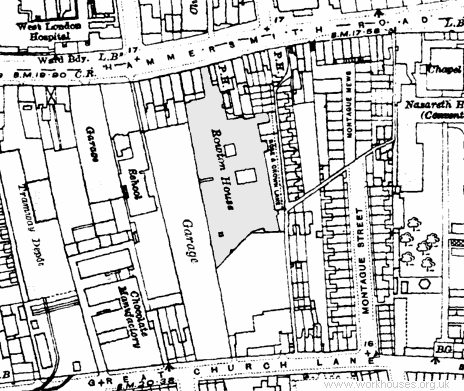
Hammersmith Rowton House site, 1916.
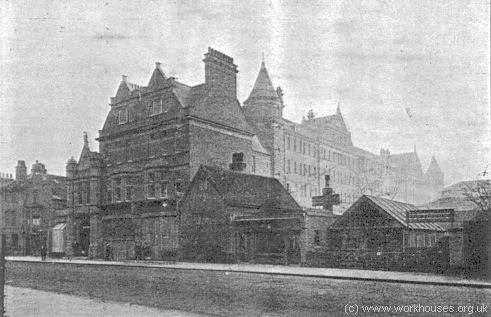
Hammersmith Rowton House, 1899.
© Peter Higginbotham.
Rowton Houses were all constructed along the same basic lines. The ground floor and basement contained the entrance hallway, dining room, smoking lounge, reading room, washrooms, barber's shop, shoemaker's and tailor's rooms, clothes and boot cleaning rooms, parcels room etc. The upper floors contained large numbers of private cubicles each of which contained a bed, chair, shelf, and a chamber pot. Residence in the establishment cost 6d per day although no access to the cubicles was permitted during the daytime. Lodgers could either buy food in the dining-hall or cook their own food.
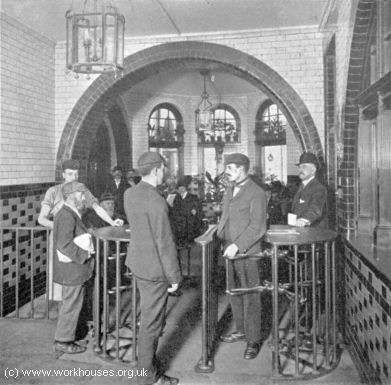
Hammersmith Rowton House entrance, 1899.
© Peter Higginbotham.
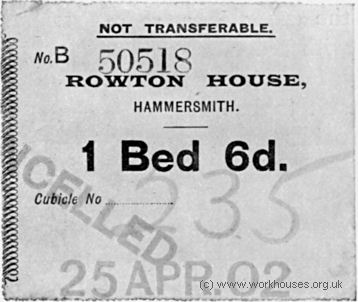
Hammersmith Rowton House admission ticket, 1899.
© Peter Higginbotham.
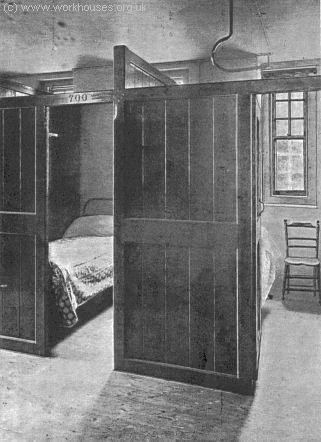
Hammersmith Rowton House bedroom cubicles, 1899.
© Peter Higginbotham.
Here is a description of the Hammersmith Rowton House from 1899:
Bath Rooms and Shops.
The new premises in Hammersmith have been fitted with all the completeness of the other houses. There are dining-rooms, a smoking-room, a reading and writing room, bath-rooms, a shoemaker's shop, lodger's store rooms and lockers - all on the ground floor or basement. Three stairways admit to the cubicles above.
Not only have the lodgers bath-rooms; there is a dressing-room provided in the bath corridor to enable lodgers to change their garments during the hours that access is not permitted to the cubicles. A special washhouse is provided for the use of lodgers who may wish to wash their own garments. The walls are of glazed bricks, and the place is fitted with ten washing troughs in ivory glazed fireclay, hot and cold water supply to each, and a large heating stove, surrounded by a galvanised iron framework for the speedy drying of garments. The lavatory is a specially large room, where eighty men can wash at the same time. Each basin is supplied with hot and cold water, and towel and hat rails adjoining. Opening out of the lavatory is a feet-washing room, with eight troughs divided by teak boards. On the other side of the lavatory are the shoemaker's and tailor's shops, adjoining which a space has been specially fitted out for the lodgers to clean their clothes and boots.
The Recreative Side.
Chief in this connection is the reading-room. A good assortment of books is provided, although the superintendent must be appealed to before a book can be removed from the shelves. The books are stored in cases with glass doors, so that the titles can easily be read from the outside. A lodger need but to mention the book he wants, and he secures it for the evening. The tables here will seat some 176 men, while any number of others can make use of the easy chairs, and gather round any one of the four large fire-places. The pictures on the walls, here as everywhere else in the building are of an artistic kind, though one could wish they had not all been framed alike.
Next to the reading-room, nearer the entrance, is the smoking-room, with table accommodation for 164 lodgers, and plenty of easy chairs. There are three fire-places with overmantels. A large fire-place bay window gives view into a courtyard. The lodgers have also a smoking-lounge in the open air. It occupies the whole of the frontage opposite the dining-rooms, and has a sheltering roof.
At Meal Times.
Nothing has been forgotten in the way of providing for the lodgers comfort at meal times. Two spacious dining-rooms have been provided, and in one of them is the shop where the lodgers can buy well-nigh anything in the way of eatables and drinkables, from sums ranging from a farthing to a penny. The shop holds a tobacco licence. Seating at tables is provided in the two dining-rooms for 464 men, and in addition a number of extra seats and wooden easy-chairs are available. Four large cooking ranges, with ovens, hot-plates, and grills, are at the lodgers' service, and boiling water can always be had for making tea. A scullery is placed between the two dining-rooms, to enable lodgers who wish to prepare their own food for cooking to do so out of the dining-rooms. Another room is reserved for keeping crocking, cooking utensils, teapots, and the like. Lodgers who cook their own food have the free use of all the things here. They are not expected to clean them. The various articles are left in the dining-rooms after use, and afterwards collected by the attendants.
The Lodgers' Bedrooms.
As to the bed rooms or cubicles, the whole 800 of them are accommodated on five floors. Each bed is in a separate cubicle, with a window to each as well as a chair, shelf, and clothes hooks. The cubicles are approached by three fireproof staircases, built in ivory glazed brickwork, two situated at the south boundary of the site, one adjoining the office, and all at the extreme ends of cubicle corridors. The disposition of the staircases renders it an impossibility to be trapped by fire, in the event of an outbreak, as the cubicle corridors run from staircase to staircase, thereby leaving open a way for retreat in the event of access to one staircase being blocked. In addition, each floor is divided by divisional walls into eleven sections, which would check, if not stop, the progress of a fire horizontally. The sectioning of the floors also enables isolation and efficient fumigation in the event of a case of contagious disease.
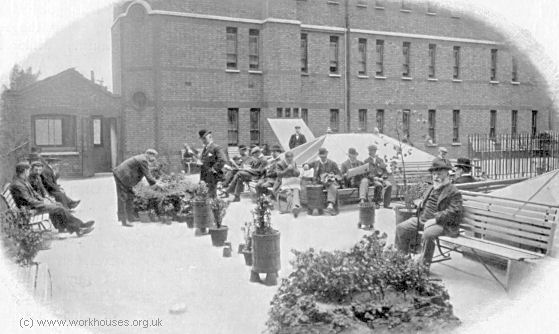
Hammersmith Rowton House inner courtyard, 1899.
© Peter Higginbotham.
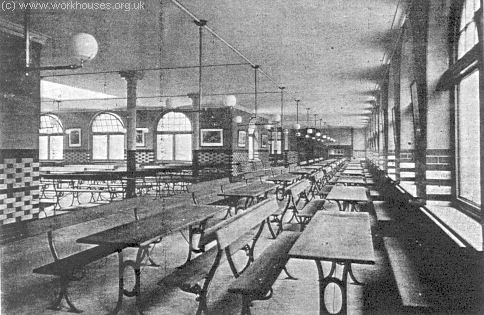
Hammersmith Rowton House dining hall, 1899.
© Peter Higginbotham.
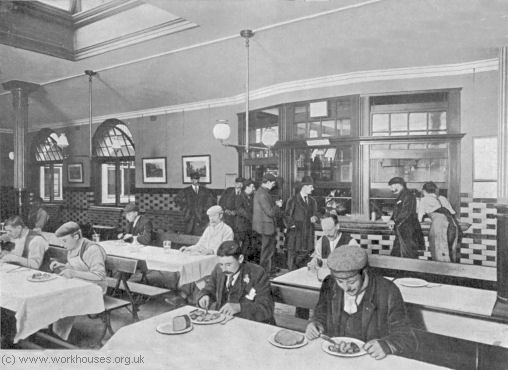
Hammersmith Rowton House dining hall, 1899.
© Peter Higginbotham.
The Hammersmith Rowton, then known as Butterwick House, closed in April 1972, with the building being demolished in a subsequent redevelopment.
Other Rowton Houses
The other Rowton Houses in London were:
- Vauxhall — opened 31st December 1892
- King's Cross — opened 1st February 1896
- Newington Butts — opened 3rd December 1897
- Whitechapel — opened 11th August 1902
- Camden Town — opened 7th December 1905
A number of Rowton-style hostels were also opened outside London, such as the Birmingham Rowton House in 1903.
Bibliography
- Cornes, James (1905) Modern Housing in Town & Country (London: Batsford)
- Farrant, Richard (1904) Lord Rowton and Rowton Houses in Cornhill Magazine, June 1904.
- Sheridan, Michael (1956) Rowton Houses 1892-1954 (London: Rowton Houses Ltd)
Links
- None.
Unless otherwise indicated, this page () is copyright Peter Higginbotham. Contents may not be reproduced without permission.


